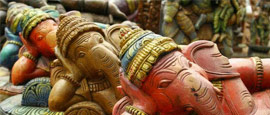Named after England's patron saint, this fort was built in 1644 and was the first bastion of power for the British East India Company and the oldest British construction in the country. The sprawling compound houses the State Legislature and Secretariat. The Fort Museum contains assorted relics from the British Raj, including weaponry, silverware, portraits and military uniforms, as well as Indian antiquities, porcelain and silverware.
Things to see in Chennai (Madras)
Tourist offices
Address: 154 Anna Salai, Chennai, 600002, India
Tel: +91 44 2846 1459.
Opening Hours:Mon-Fri 0900-1800. www.incredibleindia.org
The national tourist office is the best place for information on things to do and see in Tamil Nadu and across the country. They have reams of brochures and maps that may steer you towards attractions you might not have thought of.
Named after King George V, George Town has long been the historical and also commercial hub of the city. Along Popham's Broadway are the beautiful Armenian Church (1772) and Wesleyan Church (1820). Chennai’s longest road, Mint Street, starts near Central Railway Station and threads 4km (2 miles) towards Vallalar Nagar. Also look out for the High Court Buildings and Old Lighthouse Tower.
Constructed as part of the 18th-century Pantheon Complex, the Government Museum is housed in one of the finest colonial buildings in the subcontinent. The museum displays the state’s archaeological collection, including impressive galleries of South Indian Buddhist and Hindu stone sculptures and bronzes, plus displays on natural history, and anthropology. Also in the complex are the Connemara Public Library and National Art Gallery.
Steeped in mythology, the striking 30m-high (120ft) gopuram tower of this ancient Dravidian temple dominates the street. Said to be founded in the 7th century, its oldest inscriptions date to AD1250. Dedicated to Lord Shiva, 63 Shaivite saints adorn the courtyard – the only area non-Hindus are permitted to enter.
Stretching 18km (11 miles), Marina Beach is the world’s second longest beach, though strong currents mean visitors don’t tend to swim. Instead, people watch in the evening when the sands overflow with families, fortune-tellers and vendors. The promenade has statues of scholars and local heroes. Further on, Elliot's Beach holds Velankanni Church, and the Ashtalakshmi temple, which enshrines eight forms of the Hindu goddess Lakshmi.
Opened in 1976, this massive auditorium was constructed in memory of the poet-saint Thiruvalluvar. All 1,330 verses of his epic work, The Thirukkural, are inscribed on the surrounding granite pillars. The central feature is a 30m-high (100ft) sculpture of a chariot, inspired by ancient Dravidian temples like the Sun Temple at Konark. There is a life-size image of the poet inside.
Adjacent to Raj Bhavan, this forest reserve is home hundreds of native species, including rare black buck, spotted deer, jackals, mongoose, snakes, geckos, plus over 60 types of butterfly and 100 species of bird, including parakeets, kingfishers and lapwings. It’s nature trails and lakes are great for getting away from the noise and chaos of urban India for a few hours.
Built in 1892, this red Indo-Saracenic structure is one of Chennai's main landmarks. The world’s second largest judicial building after the Courts of London, it remains a working court, with Madras Law College in the same complex. Thronging with lawyers, students and defendants, tours and courtroom visits are available through the registrar.
This church is centred on a tiny, rock-hewn cave where St Thomas is believed to have lived when he came to India around AD58. Reputedly fleeing villagers who objected to his teachings, the saint left an imprint of his hand near the entrance. Entry is via a church built in 1551, which enshrines a stone cross that St Thomas is said to have clutched as he died, after being fatally speared by the mob.
This elegant cathedral is believed to mark the spot where St Thomas the Apostle was buried after being killed by a mob in AD78. The Portuguese built the original church in the 16th century, but the current basilica dates from 1896. Its stunning stained glass window portrays the story of St Thomas, and the central hall has 14 wooden Stations of the Cross.
Do you have any Feedback about this page?
© 2025 Columbus Travel Media Ltd. All rights reserved. No part of this site may be reproduced without our written permission, click here for information on Columbus Content Solutions.








 You know where
You know where